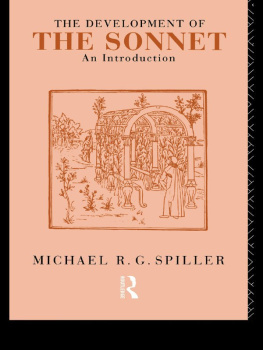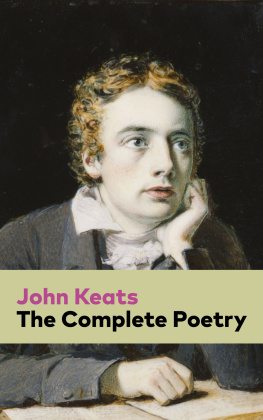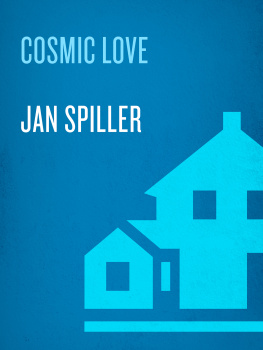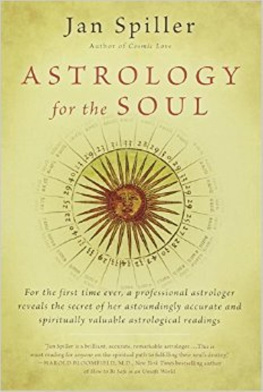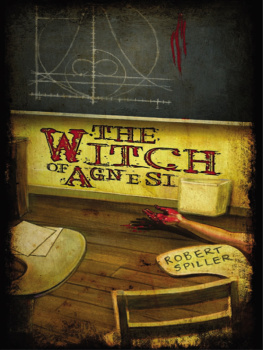MICHAEL R. G. SPILLER - The Development of the Sonnet
Here you can read online MICHAEL R. G. SPILLER - The Development of the Sonnet full text of the book (entire story) in english for free. Download pdf and epub, get meaning, cover and reviews about this ebook. year: 2011, publisher: Routledge, genre: Art. Description of the work, (preface) as well as reviews are available. Best literature library LitArk.com created for fans of good reading and offers a wide selection of genres:
Romance novel
Science fiction
Adventure
Detective
Science
History
Home and family
Prose
Art
Politics
Computer
Non-fiction
Religion
Business
Children
Humor
Choose a favorite category and find really read worthwhile books. Enjoy immersion in the world of imagination, feel the emotions of the characters or learn something new for yourself, make an fascinating discovery.
- Book:The Development of the Sonnet
- Author:
- Publisher:Routledge
- Genre:
- Year:2011
- Rating:3 / 5
- Favourites:Add to favourites
- Your mark:
- 60
- 1
- 2
- 3
- 4
- 5
The Development of the Sonnet: summary, description and annotation
We offer to read an annotation, description, summary or preface (depends on what the author of the book "The Development of the Sonnet" wrote himself). If you haven't found the necessary information about the book — write in the comments, we will try to find it.
The Development of the Sonnet — read online for free the complete book (whole text) full work
Below is the text of the book, divided by pages. System saving the place of the last page read, allows you to conveniently read the book "The Development of the Sonnet" online for free, without having to search again every time where you left off. Put a bookmark, and you can go to the page where you finished reading at any time.
Font size:
Interval:
Bookmark:

A very useful book indeed, and one which will add to the scope of current debates about the sonnet.
John Drakakis, University of Stirling
In this indispensable introductory study of the Renaissance sonnet, Michael R.G.Spiller takes the reader on an illuminating guided tour. He begins with the invention of the sonnet in thirteenth-century Italy and traces its progress through to the time of Milton, showing how the form has developed and acquired the capacity to express lyrically the nature of the desiring self. In doing so Spiller provides a concise critical account of the major British sonnet writers in relation to the sonnets history.
This volume is tailor-made for students needs and will be an essential purchase for anyone studying this enduring poetic form. Poets covered include:
Petrarch
Wyatt
Sidney
Shakespeare
Spenser
Dante
Milton
Michael R.G.Spiller is Senior Lecturer in English and Cultural History at the University of Aberdeen.
THE SONNET

First published 1992 by Routledge 11 New Fetter Lane, London EC4P 4EE
This edition published in the Taylor & Francis e-Library, 2005.
To purchase your own copy of this or any of Taylor & Francis or Routledges collection of thousands of eBooks please go to www.eBookstore.tandf.co.uk.
Simultaneously published in the USA and Canada
by Routledge
29 West 35th Street, New York, NY 10001
1992 Michael R.G.Spiller
All rights reserved. No part of this book may be reprinted or reproduced or utilized in any form or by any electronic, mechanical, or other means, now known or hereafter invented, including photocopying and recording, or in any information storage or retrieval system, without permission in writing from the publishers.
British Library Cataloguing in Publication Data
A catalogue record for this book is available from the British Library.
Library of Congress Cataloging in Publication Data
Spiller, Michael R.G.
The development of the sonnet: an introduction/Michael R.G.Spiller.
p. cm.
Includes bibliographical references and index.
1. English poetryEarly modern, 15001700History and criticism. 2. Sonnets, EnglishHistory and criticism. 3. Sonnets, English Italian influences. 4. Sonnet. I. Title.
PR539.S7S65 1993
821'.04209dc20 924868
ISBN 0-203-40150-6 Master e-book ISBN
ISBN 0-203-40177-8 (Adobe eReader Format)
ISBN 0-415-07744-3 (Print Edition)
0-415-08741-4 pbk
il soave mio fido conforto
The greatest sonneteer of them all, Francis Petrarch, looking back many years after the death of his beloved Laura upon what he had written with so much art and so much longing, said that
quantio di lei parlai n scrissi.
fu breve stilla dinfiniti abissi.
[Whatever I wrote of her was a small drop out of infinite depths.]
He meant to praise her, not his own sonnets; but spoke perhaps better than he knew, for the sonnet is at once small, and clearly formed, and capable of holding desires from the most tremendous depths. If it were not so, it would not have been used consistently and continuously by the poets of Europe from its invention in southern Italy about 1235, a hundred years before Petrarch saw his Laura, to the present day.
My own task has been to look at the sonnet in Renaissance Britain and, by concentrating upon those sonnet-writers who seem to have done most to extend its powers, show how the self and its desires were imaged. As for what came before, considerations of length and practical use to students of the form have urged me to make choices: Petrarch, of course, is massively and justly there, but as the history of the sonnet does not often take much notice of the century before him I have discussed the sonneteers of the thirteenth century at some length, with lots of examples, all translated, both because that is when the parameters of the sonnet were formed and because the Italian material is widely scattered and difficult to get at for those with little or no knowledge of the language. I have passed over many later sonneteers of great merit, such as the Italian women poets, Lorenzo dei Medici, Michelangelo and others, who are good but of less relevance to the British sonnet; and the excellent work of Walter Monch, Sidney Lee, Janet Scott, Gary Waller and others has made it possible for me to deal lightly with the French sonnet, knowing that sources and themes are accessible to the student elsewhere.
Sonnets are all alike in form; but they can be, and were, used to talk about anything at all, and in critical discussion I have used concepts and ideas freely, as they seemed to have explanatory force. If there is a critical bias, it is against the view of the sonnet as a piece of lyrical autobiographyif that view any longer needs opposing.
Sonnets not in English are taken from available critical editions or anthologies that libraries in Britain are likely to have, and are usually in modern spelling; British sonnets are reproduced either from the original texts or in the original form from a critical edition, with the accepted alterations of i to j and u to v. All translations are my own unless assigned to someone else. For the help I have received from friends, colleagues and above all from my family, I am sincerely grateful; and my students over the years have, I hope, at least taught me what it is I ought to teach them in such a book as this.
MS
THE SONNET AND ITS SPACE
And if no peece of Chronicle wee prove,
We'll build in sonnets pretty roomes;
As well a well wrought urne becomes
The greatest ashes, as half-acre tombes.
(Zohn Donne, The Canonization)
The sonnet is Donnes original well wrought urnecompact, shapely, highly finished, and able to contain, in concentrated form, almost all that is human. Donne wrote when the sonneteering vogue was at its height in England, in the years 15801610, and was perfectly familiar with the sonnet, singly or in groups, as the commemorator of love, when every Jack could promise his Jill that
though that Laura better limned bee,
Suffice, thou shalt be lov'd as well as shee.
Petrarchs achievement of a sequence of 317 sonnets and forty-nine other poems in praise of his love for one woman, his Laura, though it was imperfectly understood, was the glass of fashion and the mould of form for European sonneteers from the Renaissance to the nineteenth century. But love is not the only occupation of the sonnet, nor was it for Petrarch himself; its astonishing success and persistence has to be explained by recourse to rather wider terms.
The sonnet was invented about the year AD 1230, in southern Italy; and by the end of the thirteenth centuryspeaking, than ever before, most contemporary poetseven such apparently wild men as e.e. cummingshave at least one or two sonnets among their lyrics. The existence of hundreds of thousands of sonnets in all the vernaculars of western Europe proves that, for 750 years at least, the sonnet has been challenging and satisfying the poetic imagination.
The sonnet is probably the longest-lived of all poetic forms, and certainly the longest-lived of all prescribed forms
Font size:
Interval:
Bookmark:
Similar books «The Development of the Sonnet»
Look at similar books to The Development of the Sonnet. We have selected literature similar in name and meaning in the hope of providing readers with more options to find new, interesting, not yet read works.
Discussion, reviews of the book The Development of the Sonnet and just readers' own opinions. Leave your comments, write what you think about the work, its meaning or the main characters. Specify what exactly you liked and what you didn't like, and why you think so.

